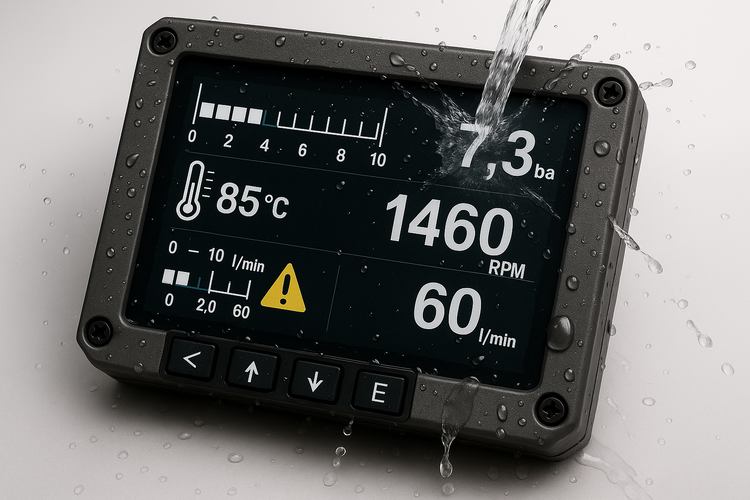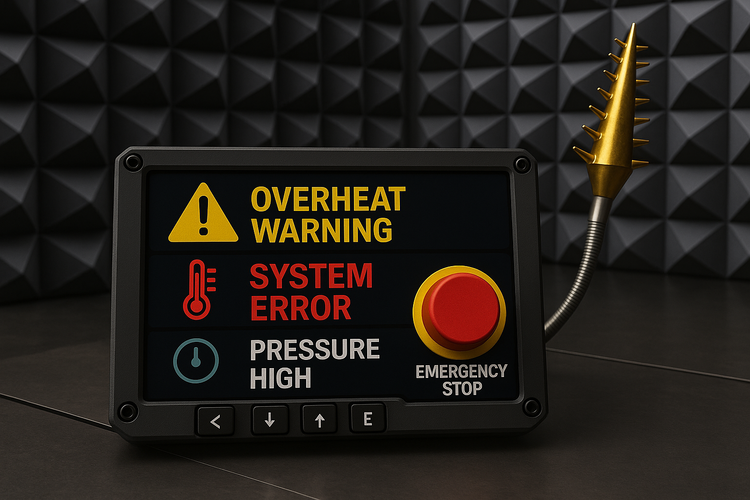Industries
Customized HMI solutions for mechanical engineering — robust, durable and precise
Touch displays, optical bonding & control panels especially for industrial requirements
Why standard HMIs are often not enough in mechanical engineering
Mechanical engineering places particularly high demands on the technology used: precision, reliability and comprehensive protection against dust, moisture, shocks and vibrations are essential here. Standard solutions are often unable to cope with these complex conditions and therefore quickly reach their limits, meaning that specialized, robust and application-oriented HMI systems are required.
Here you will find some of the most important requirements for HMIs in mechanical engineering:
User friendliness
User-friendliness (usability) is a key criterion for HMIs in mechanical engineering. Intuitive operation with clear symbols and logically structured menu navigation enables users to control machines quickly and safely. Unnecessary complexity should be avoided in order to reduce operating errors and minimize training time. A clearly structured interface not only supports efficiency in day-to-day work, but also makes a decisive contribution to safety and reliability.

Safety and compliance with standards
Safety and compliance with standards are essential in mechanical engineering in order to reliably protect operators and systems. Compliance with relevant standards such as EN ISO 13849 or IEC 60204–1 ensures that HMIs meet the legal requirements. A clearly recognizable

Mechanical resistance
Robustness and reliability play a central role in mechanical engineering, as HMIs must be able to operate permanently under harsh industrial conditions. They need to be highly resistant to dust, vibration, temperature and moisture in order to ensure continuous operation. Mechanical resistance is just as crucial and very important to ensure that the housing and operating elements remain undamaged even under heavy loads or impacts.

Protection against liquids
In mechanical engineering, devices are often exposed to harsh environmental conditions and must therefore be cleaned and maintained regularly. The systems should be fully resistant to the ingress of dust, oil, coolants and lubricants, chips, moisture or water. In mechanical engineering,

Presentation of information
A precise presentation of information on the display is crucial in mechanical engineering in order to monitor work processes safely and efficiently. Process statuses and machine parameters should be clearly structured and displayed with optimized legibility, whereby

Electromagnetic compatibility
To ensure the operational safety of machines and systems, the IEC series of standards (e.g. IEC 61000) specifies increased requirements for EMC behavior in industrial environments. This affects factors such as interference and radiation, conducted coupling and electromagnetic compatibility between controls, drives and sensors. Whether robust, transparent or opaque — your sensitive control and power electronics are reliably and permanently protected.

HMIs in mechanical engineering are characterized by a wide range of applications and diverse uses. We would like to highlight the following areas as examples:
Industrial controls:
Touchscreens, membrane keypads and front membranes enable intuitive operation and precise control of machines. In addition, mechanical or short-stroke buttons enable blind feel and operation of the buttons.
Automation technology:
Our displays and user interfaces make it easy to monitor and control automated processes.
Special machines:
Robust cover glasses, carrier plates and housings protect the operating surfaces from external influences such as dust, moisture or vibrations.
Control cabinet construction:
Customized solutions for control panels that ensure ergonomic and reliable interaction.
Our reference customers include well-known companies and institutions from the mechanical engineering sector who rely on our solutions and use them successfully in their applications:
Do you have any questions? We have the answers! In our FAQs you will find an overview of the most frequently asked questions about HMIs in medical technology. If you cannot find the right answer here, please do not hesitate to contact us directly — we will be happy to help you.
General questions

Why EP Electronic Print?
At EP Electronic Print, we rely on state-of-the-art components and technologies to develop innovative and customized HMI solutions.
Do you have any questions or would you like to find out more about our HMI solutions?
Our team will be happy to advise you and work with you to find the best solution for your project. Use our contact form or call us directly — we look forward to hearing from you!
We are here for you
Telefon: +49 (0)8142 /420896–20
E‑Mail: projekte@ep-electronicprint.de Allgemeine Anfragen:
Telefon: +49 (0)8142 /420896–0
E‑Mail: info@ep-electronicprint.de EP Electronic Print GmbH
Am Weidegrund 8 & 10
82194 Gröbenzell








